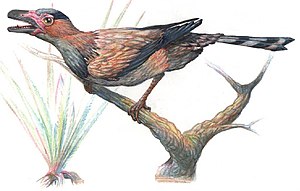Cathayornis (Syn.: Sinornis) ist ein fossiler Vogel aus der Gruppe der Enantiornithes. Mehrere beschriebene Funde wurden in der Jiufotang-Formation Liaonings im Nordosten der Volksrepublik China gemacht. Das Alter der Jiufotang-Formation wird laut Carl Swisher u. a. (1999) mit 120 bis 100 Millionen Jahren angegeben.[1] Die Wortschöpfung Cathayornis leitet sich ab von dem altertümlichen englischen Wort Cathay als Bezeichnung für China und dem altgriechischen όρνις (ornis) für Vogel.
| Cathayornis | ||||||||||||
|---|---|---|---|---|---|---|---|---|---|---|---|---|

Cathayornis, syn. Sinornis | ||||||||||||
| Zeitliches Auftreten | ||||||||||||
| Unterkreide | ||||||||||||
| 120 bis 100 Mio. Jahre | ||||||||||||
| Fundorte | ||||||||||||
| Systematik | ||||||||||||
| ||||||||||||
| Wissenschaftlicher Name | ||||||||||||
| Cathayornis | ||||||||||||
| Zhou, Jin & Zhang, 1992 bzw. Sereno & Rao, 1992 | ||||||||||||
| Art | ||||||||||||
Die Streitfrage um die richtige Namensgebung ist aber noch immer nicht geklärt. Zhou und Hou (2001) unterscheiden Cathayornis von Sinornis anhand folgender wesentlicher Merkmale:
- Cathayornis ist größer
- sein erster Finger ist länger und gerader
- er besitzt keinen Atitrochanter
Sie haben Cathayornis den Artnamen Cathayornis yandica verliehen.[2]
Paul Sereno und andere (2001) sehen jedoch in Cathayornis nur ein Synonym (Zweitbeschreibung) von Sinornis. Für sie ist der anatomische Aufbau der beiden sehr ähnlich, so haben beide Formen zum Beispiel auch die gleiche zentrale Autapomorphie des Pygostyls. Sie haben Sinornis mit dem Artnamen Sinornis santensis versehen.[3]
Nach Cathayornis wurde die fossile Avifauna in der Jiufotang-Formation benannt, die so genannte Cathayornis-Chaoyangia-Avifauna.
In ihr sind folgende Vogelarten vertreten:[4]
- Cathayornis yandica oder Sinornis santensis
- Chaoyangia beishanensis
sowie:
Einzelnachweise
Bearbeiten- ↑ Carl C. Swisher III, Yuan-Qing Wang, Xiao-Lin Wang, Xing Xu, Yuan Wang: Cretaceous age for the feathered dinosaurs of Liaoning, China. In: Nature. 400, Nr. 6739, 1999, S. 58–61, doi:10.1038/21872.
- ↑ Zhong-He Zhou, Lianhai Hou: The Discovery and Study of Mesozoic Fossil Birds in China. In: Luis M. Chiappe, Lawrence M. Witmer (Hrsg.): Mesozoic Birds. Above the Heads of the Dinosaurs. University of California Press, Berkeley 2002, ISBN 0-520-20094-2.
- ↑ Paul Sereno, Rao Chenggang, Jianjun Li: Sinornis santensis (Aves: Enantiornithes) from the Early Cretaceous of Northeastern China. In: Luis M. Chiappe, Lawrence M. Witmer (Hrsg.): Mesozoic Birds. Above the Heads of the Dinosaurs. University of California Press, Berkeley 2002, ISBN 0-520-20094-2.
- ↑ Zhonghe Zhou, Paul M. Barett, Jason Hilton: An exceptionally preserved Lower Cretaceous ecosystem. In: Nature. 421, Nr. 6925, 2003, S. 807–814, doi:10.1038/nature01420.